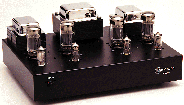

Tube amplifiers have a relatively simple design topology, unlike solid-state amplifiers which require far more components to achieve the same result. And as Hi-Fi goes the fewer components you have in a signals path, the purer the signal!
 My involvement with tube amplifiers began when I was looking to upgrade my Rotel 820BX integrated amplifier (which I had many happy years of use) with something more upmarket. It lead to my getting a pair of Leak TL/25 Plus (es). They differ somewhat from the original model as they had been modified by Glen Croft, which meant that a tube regulated power supply and extra smoothing capacitors had been added (which is common of Croft's own electronics) as an improvement on the original supply.
My involvement with tube amplifiers began when I was looking to upgrade my Rotel 820BX integrated amplifier (which I had many happy years of use) with something more upmarket. It lead to my getting a pair of Leak TL/25 Plus (es). They differ somewhat from the original model as they had been modified by Glen Croft, which meant that a tube regulated power supply and extra smoothing capacitors had been added (which is common of Croft's own electronics) as an improvement on the original supply.
 There are several variations of tube amplifier designs, they are...
There are several variations of tube amplifier designs, they are...
The earliest tube amplifiers were based on the Single Ended (SE) Triode. These amplifiers run in pure Class A giving what some people consider to be the most transparent reproduction of music, due in part to the triodes' linearity across the audio range and the absence of negative feedback, however, Class A amplifiers have very low efficiency and therefore are somewhat limited in power (8-10W typical). To get more power you can go to the next stage which is Parallel Single Ended (PSE), this is identical to Single Ended amplifiers with the exception of an additional output tube in parallel with the first, this can yield higher powers up to 30W depending on tube type. Both these types of amplifier demand very high efficiency loudspeakers (90dB typical) to deliver a respectable volume without compromising the amplifier's headroom. Horn loaded speakers are an ideal load for low powered SE amplifiers.
As you can guess both SE & PSE amplifiers are very expensive due to the nature of the components used and the increased specification (power output etc.) of the output transformers and are typically reserved for high-end equipment where the cost of production is less of a factor to the buyer.
At this present moment in time many SE amplifiers are based on the 300B tube, the 300B is by no means the only triode around, higher powers can be obtained by the use of another triode such as the 845. The only difference being the high voltages required for the anode and the impedance of the output transformer.
 In an effort to gain more power Push Pull operation was adopted, the first example of this method was produced by Williamson and provided the basis of high powered amplifiers for many years. Push Pull operation is usually achieved by operating the tubes between Class AB and Class B, this results in a greater efficiency and increased output power. There is however, a small penalty involved in this method of operation, namely crossover distortion which can be caused by incorrect biasing of the tubes and notch distortion which is the product of the output transformer.
In an effort to gain more power Push Pull operation was adopted, the first example of this method was produced by Williamson and provided the basis of high powered amplifiers for many years. Push Pull operation is usually achieved by operating the tubes between Class AB and Class B, this results in a greater efficiency and increased output power. There is however, a small penalty involved in this method of operation, namely crossover distortion which can be caused by incorrect biasing of the tubes and notch distortion which is the product of the output transformer.
In an effort to eliminate these types of distortions the Output Transformer Less (OTL) topology was developed by people such as Futterman. This method completely removes the output transformer from the amplifier and the distortions that can be attributed to its construction. At first glance OTL amplifiers seem like a dream come true, except that they can be very complex and costly to implement. Despite the expense, OTL amplifiers still remain popular with amateur constructors.
 |
 |